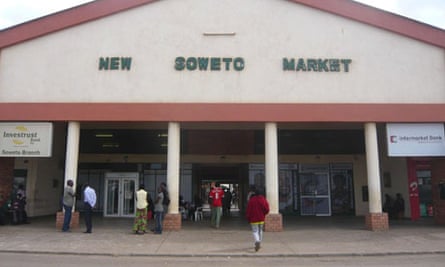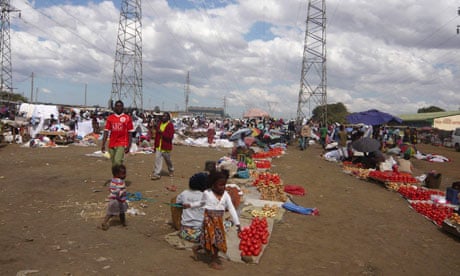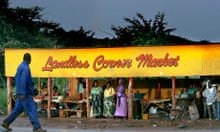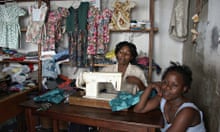The neatly laid out kiosks, with their red brick walls and green corrugated roofs, give the new Soweto market near the city centre a tidy and orderly air. Too much so.
The bustle and crowds of what should be a vibrant meeting point between vendors and customers are lacking. Instead, the market is a forlorn place, particularly the two large covered sections that dominate the area. In one, women are selling dried tobacco leaves, with an acrid odour so pungent it tickles the back of the throat. Most of the long concrete stalls that stretch across the space stand empty.
It is the same story at the other big covered section, where women sell dried fish. The new Soweto market, which opened in 2009, has capacity for 1,600 vendors, but it was easily less than half full, judging by a stroll through the premises on Monday, when both vendors and customers were thin on the ground.
Step outside the market, across an open drain, and it is a different story. On an expanse of open ground, beneath huge electricity pylons, vendors sit on mats selling tomatoes, onions or second-hand T-shirts. There is also entertainment. Two young men have set up a game, where – for a small price – punters are invited to throw rubber rings at kwacha notes laid out on the ground in concentric circles. If the ring lands round a note, they get to keep it. Yet the game is deceptive, as the rings bounce.
Nearby, Yvonne, 26, loads a kilo of tomatoes into a plastic bag and sells them for 2,500 kwacha (about 31p). A mother of four, she has been there since 7am, having travelled 12km to the market. "I would rather be out here than in the market because there are no customers inside," she said, wearing a red skirt with the words Real Madrid Futbol.
Yvonne's preference for sitting out in the open under a hot morning sun, rather than in the comfort of a covered market just a few metres away, sums up the problems for the Lusaka city authorities in their futile efforts to move street vendors from busy main roads into organised markets. The authorities argue that the street vendors exacerbate sanitation problems and congestion.
It certainly is rammed just outside one corner of the new Soweto market, where blue minibuses fight for space with crowds of shoppers and vendors selling large pots and pans, charcoal burners, sacks for the maize harvest, yams, popcorn, yellow plastic containers, small dried fish called kapenta, beans and pulses. On the other side of the street are vendors selling a colourful assortment of clothes. Compared with some other cities in the developing world, such as Addis Ababa in Ethiopia, or Dhaka in Bangladesh, Lusaka for the most part is tidy and neat, with a well-paved road. Then there are the scruffy bits where street vendors line Lumumba road for miles.

As for sanitation, Nkanda Luo, the local government minister, told the government-owned Zambia Daily Mail: "The government wants to discourage street vending because of its effects such as the spread of waterborne diseases. We will not allow people to trade in places that have no proper sanitation facilities such as toilets."
The new Soweto market and the Lusaka city market, established in the mid-1990s, were designed to take the pressure off the streets, but street vending continues to cause headaches for the city authorities. It is disingenuous of vendors to say there is not enough space at the new Soweto market. There is clearly plenty of room, but the city faces a catch-22 situation. The vendors do not want to go to the covered markets because there are no customers. But because the vendors shun these markets, shoppers have little incentive to visit.
Even when vendors want to set up at the new Soweto market, they say they cannot afford the fees. "I can't afford the charges," said Florence Banda, a 41-year-old mother of five, who sells T-shirts. She also complained about the lack of business. "We are just sitting here but people are not buying," she said, perhaps unaware that business is even slower inside the confines of new Soweto.
Zambia's new president, Michael Sata, who was sworn in last September, initially wanted to leave the street vendors alone as he counted them among his supporters. But even his government realises that the situation is untenable. There is talk of introducing set hours or days such as weekends in certain areas. Some vendors say they are willing to pay towards sanitation.
Such ideas, however, are unlikely to fill the empty stalls at the new Soweto market. "It's the business," says Oscar as he swats away flies from his pile of dried fish on a roadside stall just outside. "There is no business inside."




